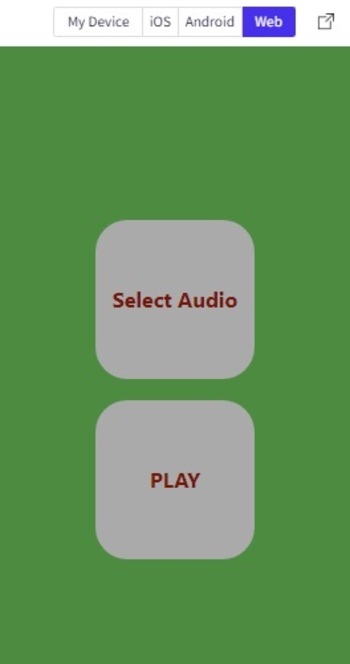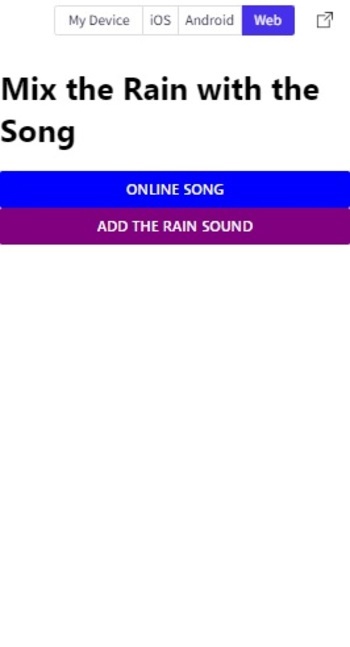使用Snack中的音频
音频是移动应用程序的常见组件。音频可以用在应用程序中的许多方面。音频可以从移动设备中选择,可以使用任何在线链接,也可以作为本地音频包含在项目本身中。Expo-av可以在所有这些情况下用于将声音集成到移动应用程序中。本文显示了React Native和JavaScript代码的三个不同示例,其中第一个示例从设备中浏览音频文件,第二个示例从在线链接中选择音频并与本地存储的音频文件混合,第三个示例演示了音频的播放和停止。
步骤-1
步骤 1 - 从’react-native’中导入View、Text、TouchableOpacity和StyleSheet。还要从’expo-av’和’expo-document-picker’中导入Audio和DocumentPicker。
步骤 2 - 创建一个名为App.js的文件。
步骤 3 - 创建一个名为selectAudioFunc的函数。现在调用DocumentPicker.getDocumentAsync函数,并从设备中获取音乐文件。
步骤 4 - 创建一个新函数,并将其命名为playyAudioo(),编写代码以播放选择的音频文件。
步骤 5 - 使用TouchableOpacity,并在点击时调用playyAudioo()。
步骤 6 - 检查结果。
示例1:从设备中选择音频文件进行播放
项目中使用的重要文件是
- App.js
示例
import {useState} from 'react';
import { TouchableOpacity, StyleSheet,View, Text } from 'react-native';
import { Audio } from 'expo-av';
import * as DocumentPicker from 'expo-document-picker';
export default function AudioExampleOne() {
var [myaudio, settAud] = useState([]);
selectAudioFunct= async ()=> {
settAud(
await DocumentPicker.getDocumentAsync({
type: 'audio/*',
copyToCacheDirectory: true,
})
);
}
playyAudioo= async ()=> {
const myAudioSrc = myaudio.uri;
const audioObj = new Audio.Sound();
audioObj.setOnPlaybackStatusUpdate();
await audioObj.loadAsync({ uri: myAudioSrc });
await audioObj.playAsync();
}
return (
<View style={styles.mainSpace}>
<View style={{ flexDirection: 'row', justifyContent: 'center' }}>
<TouchableOpacity
onPress={() => selectAudioFunct()
}
style={styles.BtnStyleIt}>
<View >
<Text style={styles.BtnTxt1}>Select Audio</Text>
</View>
</TouchableOpacity>
</View>
<View style={{ flexDirection: 'row', justifyContent: 'center' }}>
<TouchableOpacity
onPress={() =>
playyAudioo()
}
style={styles.BtnStyleIt}>
<View>
<Text style={styles.BtnTxt1}>PLAY</Text>
</View>
</TouchableOpacity>
</View>
</View>
);
}
const styles = StyleSheet.create({
mainSpace: {
flex: 1,
backgroundColor: '#4d8b40',
alignItems: 'center',
justifyContent: 'center',
},
BtnStyleIt: {
margin: 10,
width: 150,
height: 150,
borderRadius: 30,
backgroundColor: '#aaa',
alignItems: 'center',
justifyContent: 'center',
},
BtnTxt1: {
color: '#76150A',
fontSize: 20,
fontWeight: "bold",
textAlign: 'center'
},
});
输出
结果可以在线查看。

步骤-2
步骤1 – 从’react-native’导入视图、文本和按钮。
步骤2 – 创建App.js并编写代码。
步骤3 – 创建一个新函数并将其命名为theonlineSong。从音频链接中获取歌曲以获取音乐文件来测试此功能。
步骤4 – 创建一个新函数并将其命名为thelocalfile,以选择任何本地存储在同一项目中的音频文件。
步骤5 – 使用来自react-native的按钮来创建按钮,并从中调用上述函数代码。
步骤6 – 检查结果
示例2:混合在线和本地音频文件
项目中使用的重要文件是
- App.js
示例
import{Component}from'react';
import{View,Text,Button,StyleSheet}from'react-native';
import{Audio}from'expo-av';
exportdefaultclassAudioExampleTwoextendsComponent{
theonlineSong=async()=>{
awaitAudio.Sound.createAsync(
{uri:'<any_audio_file_link.mp3>'},
//Foregthislinkwasusedfordemo
//{uri:'https://pwdown.info/112168/06.%20Ek%20Aisi%20Ghazal.mp3'},
{shouldPlay:true},);}
thelocalfile=async()=>{
awaitAudio.Sound.createAsync(
{uri:require("./raining.mp3")},
{shouldPlay:true,isLooping:true},
);}
render(){
return(
<View>
<Viewstyle={{paddingTop:20}}>
<Textstyle={{
fontWeight:'bold',
fontSize:30,marginBottom:20}}
>
MixtheRainwiththeSong
</Text>
<Button
style={{paddingTop:20}}
title='OnlineSong'
color='blue'
onPress={this.theonlineSong}
>
</Button>
<Button
style={{paddingTop:20}}
title='AddtheRainSound'
color='purple'
onPress={this.thelocalfile}
>
</Button>
</View>
</View>
);
}
}
输出
结果可以在线上看到。

步骤-3
步骤1 − 从’react-native’中导入View、Text、Button。同时,从’expo-av’中导入Audio。还要从’react’中导入useState和useEffect。
步骤2 − 创建App.js并编写代码。
步骤3 − 使用Audio.Sound()创建一个新的音频对象,并使用loadAsync(require<文件名及路径>)来加载所需的音频文件。
步骤4 − 根据标志条件尝试播放和停止文件。
步骤5 − 使用react-native中的Button制作一个按钮,并在反转标志条件时更改按钮的颜色。
步骤6 − 检查结果。
示例3:开始和停止音频
项目中使用的重要文件是
- App.js
示例
import {useState,useEffect} from 'react';
import {View, Text, Button } from 'react-native';
import { Audio } from 'expo-av';
export default function AudioExampleThree() {
const [audioFlag, setaudioFlag] = useState(false)
const [rain] = useState(new Audio.Sound());
useEffect(()=>{
(async () => {
console.log('Audio Flag', audioFlag)
if (audioFlag) {
await rain.loadAsync(require("./raining.mp3"))
try {
await rain.playAsync()
} catch (e) {
console.log(e)
}
} else {
await rain.stopAsync()
await rain.unloadAsync()
}
})()
},[audioFlag, rain])
return (
<View style={{ justifyContent:"center", alignItems : "center"}}>
<Text style={{marginTop: 50, marginBottom: 50, fontSize:28}}>Rain Sound </Text>
<Buttoncolor={audioFlag ? '#d61676' : '#24dd4d'} title={'PLAY AUDIO | STOP AUDIO'} onPress={()=>setaudioFlag(!audioFlag)} />
</View>
);
}
结果
结果可以在线查看。

 极客笔记
极客笔记